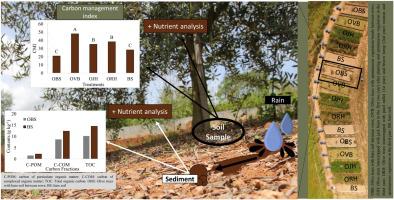Soil and Tillage Research ( IF 6.5 ) Pub Date : 2021-02-09 , DOI: 10.1016/j.still.2020.104863 Danielle Vieira Guimarães , Marx Leandro Naves Silva , Adnane Beniaich , Rafael Pio , Maria Isidória Silva Gonzaga , Junior Cesar Avanzi , Diêgo Faustolo Alves Bispo , Nilton Curi

|
Separation and transport of soil particles during an erosion event significantly reduce natural fertility of the soil and compromise the natural carbon dynamics of agricultural areas, especially in perennial crops of low plant density, as is the case of olive growing. This is a recently introduced crop in tropical regions in Brazil. Under Cwb climate conditions, characterized as a temperate rainy with a dry winter and a rainy summer, with an average annual rainfall of 1,411 mm, and average annual temperature of 19.3 °C, the aim of this study was to evaluate the dynamics and losses of soil organic matter and nutrients by water erosion in olive groves, under different management systems, in the municipality of Lavras, Minas Gerais state, Brazil. Five treatments involving the presence and absence of cover plants intercropped with olive trees were evaluated. The study of soil organic matter included determination of carbon, fractionation of soil organic matter (SOM) and of sediment and carbon management index (CMI). The results showed that maintaining spontaneous vegetation/weeds intercropped with the olive trees olive trees offered improved soil protection, mainly regarding carbon stocks, because it presented CMI increase from 20.91 up to 48.0 from non-conservationist to more conservationist olive cultivation and should, therefore, be adopted. Losses of nutrients and carbon where the olive tree is maintained without intercropping reached high levels, proving to be an unsustainable practice.
中文翻译:

热带地区橄榄树覆盖农作物管理系统中水蚀造成土壤有机质和养分的动态和损失
侵蚀事件期间土壤颗粒的分离和运输会显着降低土壤的自然肥力,并损害农业地区的自然碳动力,特别是在植物密度低的多年生作物中,例如橄榄种植。这是巴西热带地区最近引进的一种作物。在Cwb气候条件下,气候为温带雨水,冬季干燥,夏天多雨,年平均降雨量为1,411 mm,年平均温度为19.3°C,本研究的目的是评估气候变化的动态和损失。在巴西米纳斯吉拉斯州拉夫拉斯市,采用不同的管理制度,通过水力侵蚀橄榄树林土壤有机质和养分。评价了五种处理方法,其中涉及是否存在套种有橄榄树的覆盖植物。土壤有机质的研究包括碳的测定,土壤有机质的分馏(SOM),沉积物和碳管理指数(CMI)。结果表明,保持自发的植被/杂草与橄榄树间作可提供更好的土壤保护,主要涉及碳储量,因为它使CMI从非保护主义的橄榄种植提高到了更多保护主义的橄榄,从20.91上升到48.0,因此,被采用。在不间作的情况下维持橄榄树的养分和碳的流失达到了很高的水平,事实证明这是不可持续的做法。土壤有机质(SOM)和沉积物及碳管理指数(CMI)的分级。结果表明,保持自发的植被/杂草与橄榄树间作可提供更好的土壤保护,主要涉及碳储量,因为它使CMI从非保护主义的橄榄种植提高到了更多保护主义的橄榄,从20.91上升到48.0,因此,被采用。在不间作的情况下维持橄榄树的养分和碳的流失达到了很高的水平,事实证明这是不可持续的做法。土壤有机质(SOM)和沉积物及碳管理指数(CMI)的分级。结果表明,保持自发的植被/杂草与橄榄树间作可提供更好的土壤保护,主要涉及碳储量,因为它使CMI从非保护主义的橄榄种植提高到了更多保护主义的橄榄,从20.91上升到48.0,因此,被采用。在不间作的情况下维持橄榄树的养分和碳的流失达到了很高的水平,事实证明这是不可持续的做法。因为它表示CMI从非保护主义者到更多的保护主义者橄榄种植从20.91上升到48.0,因此应该采用。在不间作的情况下维持橄榄树的养分和碳的流失达到了很高的水平,事实证明这是不可持续的做法。因为它表示CMI从非保护主义者到更多的保护主义者橄榄种植从20.91上升到48.0,因此应该采用。在不间作的情况下维持橄榄树的养分和碳的流失达到了很高的水平,事实证明这是不可持续的做法。



























 京公网安备 11010802027423号
京公网安备 11010802027423号